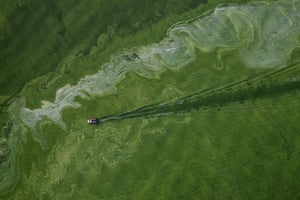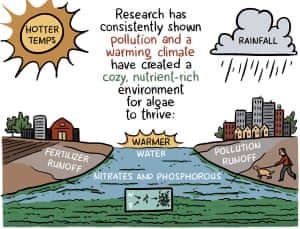https://www.theguardian.com/environment/2019/sep/18/toxic-algae-climate-change-slimy-lakes-dead-dogs
Slimy lakes and dead dogs: climate crisis has brought the season of toxic algae
Warming water and pollution are contributing to a variety of harmful bacteria that can wreak havoc on aquatic environments
From New York City to coastal California, a poison-producing living slime is overtaking waterways and shorelines, killing pets, ravaging tourism markets and making its way into local drinking water. So far this year, algae has been implicated in dog deaths and illness in California, Georgia, North Carolina and Texas. In August, toxic algae overtook Lake Erie, growing to 620 sq miles.
These biotoxic blooms can last anywhere from a few weeks to over a year.
This nationwide algae epidemic points to a sustained shift in the aquatic environment – one that experts say is being driven by pollution and the climate crisis.
“We believe climate change is really having a huge impact on the occurrence and growth of these blooms,” said Anne Schechinger, a senior analyst for the Environmental Working Group (EWG). “We know the incidence of blooms is just going to keep going up and up.”
A report by the EWG found toxic algae blooms have apparently grown in size and frequency multifold since 2010. Reports of algae outbreaks are up 22% compared to this same time last year.
“It really is a national problem,” said Schechinger. “It essentially affects everybody.”
With no government agency comprehensively tracking the total incidents of algae blooms nationwide, the EWG uses news items as a proxy. Without other available data it’s a decent measure, but only so long as algae blooms remain fresh. The more normal and less newsworthy recurring algae blooms become, the more difficult it may be to track them. And there’s every reason to believe this is the slimy, water-tainting, beach-ruining, dog-killing new normal.
Not all algae blooms are harmful, and not all harmful algae blooms are toxic. “Harmful algae bloom” is a catchall that includes a variety of photosynthesizing bacteria that can wreak havoc on both aquatic and human communities, either by depriving sealife of sunlight and oxygen, creating so-called “dead zones”; slopping up on panoramic shorelines and ravaging tourism economies; or producing water and airborne toxins that can kill.
A partnership between the Environmental Protection Agency (EPA), Nasa, Noaa and the US Geological Survey monitors water across the country for algae blooms using satellite imagery, but most of the onerous and expensive toxin tracking is left to state agencies.
“It really is up to the states to keep people safe from this, and not a lot of states are even doing any monitoring,” said Schechinger. “This is going to be a wakeup call to a lot of these states that they need to be doing more.”
But even where some places are testing for algae-produced toxins, there are currently no limits on how much algae-produced toxin, considered an “unregulated contaminant”, is allowable in drinking water under current law.
Dr Don Anderson, director of the US National Office for Harmful Algal Blooms at the Woods Hole Oceanographic Institute, described algae blooms as “formidable competitors” made all the more dangerous by warming water.
Some research has linked exposure to cyanobacteria, more commonly known as “blue-green algae”, to neurological disease, including ALS. Anderson contends far more research is needed to know how humans might fare with prolonged exposure to pervasive algae toxins..
“I am not skeptical about the fact that these cyanobacteria produce a lot of really nasty compounds and people are being exposed to them occasionally through drinking water but also through recreation – or even just walking around a lake and breathing,” said Anderson.
It is possible to treat water to remove cyanobacterial toxins, but the most obvious and cost-effective way to stop these blooms is stemming the stream of nutrient pollution: reducing runoff from cities and farms with buffer zones between agricultural land and waterways.
“If we can stop these nutrients from flowing into the water, we could prevent these blooms in the first place,” said Schechinger.
Like monitoring, buffer zones are not required by law – and they may still not be enough to stop the spread of algae. Where legacy nutrients are stored in the watershed, algae can bloom without any new food.
“A lot of the damage has already been done down there in the sediments,” said Anderson. “It’s a daunting problem, and it’s not going to be an easy one to mitigate.”
And, said Schechinger: “The season’s not over yet.”



沒有留言:
張貼留言